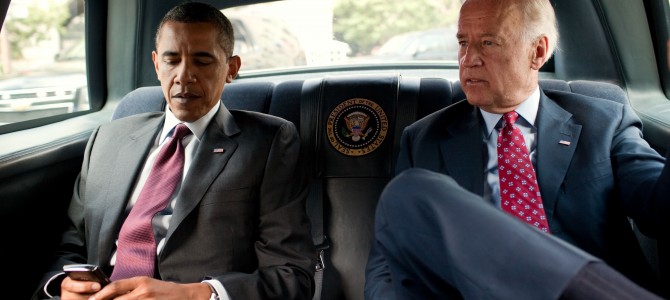
The drip-drip-drip of newly declassified documents related to the Trump-Russia investigation, together with recent reports that a classified leak against former National Security Advisor Michael Flynn might not have come from an unmasking request, leaves little doubt that the Obama administration weaponized federal surveillance laws to target Trump associates and undermine the incoming administration.
The story thus far is complex, but it reveals a disturbing abuse of power by the Obama administration that suggests congressional reform of federal surveillance laws is needed to ensure this never happens again.
The latest declassified document, an email written by former White House National Security Adviser Susan Rice detailing a high-level Oval Office meeting on January 5, 2017, directly implicates then-President Obama and other top officials in the targeting of Flynn, including then-Vice President Joe Biden and fired Federal Bureau of Investigations Director James Comey.
According to Rice’s bizarre email, which she wrote to herself as President Trump was being inaugurated on Jan. 20, 2017, Comey told Obama and Biden he had “some concerns that incoming NSA Flynn is speaking frequently with Russian Ambassador Kislyak,” and that “the level of communication is unusual.” How did Comey know this? Because the FBI had been spying on Flynn as part of a counterintelligence investigation it launched in August 2016.
Flynn’s conversations with the Russian ambassador became national news after someone in the Obama administration illegally leaked to Washington Post columnist David Ignatius, who revealed in a Jan. 12, 2017, column that Flynn had spoken to Kislyak several times on Dec. 29, 2016.
That touched off an effort by Republicans to find out who leaked to the Post. Last week, responding to a request from Sens. Ron Johnson (R-Wis.) and Chuck Grassley (R-Iowa), acting Director of National Intelligence Richard Grenell released a list of former senior Obama administration officials who requested the unmasking of Flynn between Nov. 30, 2016, and Jan. 12, 2017.
The list was revealing. During those weeks, no fewer than 39 Obama administration officials unmasked Flynn, from senior people like Comey and former Director of National Intelligence James Clapper, to people who had no conceivable reason for unmasking Flynn, like former U.S. Ambassador to the United Nations Samantha Power and Obama’s chief of staff, Denis McDonough. Even Biden was on the list.
The sheer number of unmasking requests for Flynn, combined with a disturbing pattern of deception by former Obama officials about the unmaskings, raises serious questions about why the outgoing Obama administration was targeting Trump’s incoming national security advisor, and whether it did so as a pretext to continue the Trump-Russia collusion probe after Trump took office.
But the dates of the unmasking requests don’t match up with Flynn’s Dec. 29 conversations with the Russian ambassador, which suggests Flynn was identified in an intelligence report that didn’t require the concealment of his identity. On Wednesday, the Washington Post reported that, according to an anonymous former senior U.S. official, “When the FBI circulated [the report], they included Flynn’s name from the beginning,” and that, “There were therefore no requests for the unmasking of that information.”
This report matches with a theory floated over the weekend by National Review Online’s Andrew McCarthy, that Flynn’s call with Kislyak might have been “intercepted under an intelligence program not subject to the masking rules, probably by the CIA or a friendly foreign spy service acting in a nod-and-wink arrangement with our intelligence community.”
Others have speculated that Flynn’s identity was not masked because he was the target of a counterintelligence investigation by the FBI, a fact Comey never shared with Trump as he was preparing to take office. Even worse, the counterintelligence investigation continued at a “deep state” level after Trump took office, as the FBI agents involved appear to have concealed the fact of the investigation from Department of Justice leadership.
All of this leaves more questions than answers. But Democrats and the mainstream media are scrambling to dismiss the whole thing by insisting Obama committed no crime in the course of the Trump-Russia investigation, and neither did Biden, and neither did anyone else.
The media even construed Attorney General William Barr’s comments Monday, in which he called the Trump-Russia probe a “grave injustice” that was “unprecedented in U.S. history,” as a dismissal of the “Obamagate” plot to undermine Trump’s presidency, even though Barr appeared to suggest that the Department is looking for potential criminality by Obama administration officials other than Obama and Biden. In other words, nothing to see here folks, move along.
A Brief History of Surveillance Abuse and FISA
But Obama and Biden and other top law enforcement and intelligence officials need not have committed crimes to have egregiously abused their power. It now appears that Obama officials used intelligence authorities to defeat the entire purpose of the Federal Intelligence Surveillance Act—that is, to do the very thing that led to the creation of FISA: spy on their political opponents.
To understand how they did this, a bit of historical context is in order. Congress passed FISA in 1978 as a result of the Church Committee hearings, which were convened in response to revelations that President Richard Nixon and prior presidents had used the FBI and CIA to spy on U.S. citizens and organizations, including antiwar groups and political dissidents. The Nixon administration’s widespread wiretapping of U.S. citizens, including his political opponents, shocked the nation. But, strictly speaking, it wasn’t illegal.
Before FISA, the U.S. Supreme Court had upheld warrantless wiretaps if the primary purpose was gathering foreign intelligence, but had also ruled that court approval was required for domestic surveillance to satisfy the Fourth Amendment, citing the “inherent vagueness of the domestic security concept” and warning of the potential for abuses.
That’s why Congress passed FISA. The law established procedures for collecting intelligence and conducting electronic surveillance on “foreign powers” and “agents of foreign powers” suspected of espionage or terrorism. It also created the FISA court to oversee request for surveillance warrants by U.S. law enforcement and intelligence agencies. The idea was that if executive branch agencies were going to conduct secret electronic surveillance, there needed to be some congressional and judicial oversight so foreign intelligence collection wasn’t used as an excuse to spy on Americans.
Toward that end, FISA relied on privacy protections for U.S. citizens called “minimization procedures” that redact or “mask” the identities of Americans incidentally caught up in the surveillance of foreign nationals and suspected clandestine agents of foreign powers. Officials with national-security or foreign-relations responsibilities have the authority to unmask these Americans if they believe that information is necessary.
Usually, unmasking requests are made by specialists in the FBI or the NSA, and careful records are kept of these requests by the Office of the Director of National Intelligence. The practice of unmasking became more widespread during the Obama administration and has continued under Trump, although in theory it’s meant to be limited only to situations where intelligence agencies need to know the identity of a U.S. citizen in order to understand the full context or meaning of the intelligence being collected.
Obama Admin Distorted FISA Beyond Recognition
Proponents of FISA likely never imagined that warrants for electronic surveillance or unmasking requests might be used by an outgoing administration to spy on an incoming one, but that appears to be what happened in the Trump-Russia investigation and the targeting of Flynn.
We’ll likely know more soon. Sens. Johnson and Grassley have since expanded their request, calling for the release of records related to the unmasking of Trump campaign affiliates by Obama officials from January 2016 to January 2017. The senators say they’re concerned that surveillance of the Trump campaign began long before the FBI launched its counterintelligence investigation, Crossfire Hurricane, which became the basis for the Robert Mueller probe and years of conspiracy theories about Trump colluding with Russia.
We don’t yet know where all this will lead, but it seems increasingly clear that the Obama administration managed to thwart the entire purpose of FISA, particularly its minimization protections, transforming them from a safeguard against domestic political spying into a vehicle for Obama to do just that.
Like the aftermath of the Nixon presidency, now might be the time for a 21st-century version of the Church Committee. If Obama used intelligence capabilities to spy on the Trump campaign—and gave the green light to Comey to continue spying on the administration after Trump took office—then our intelligence and surveillance laws will need to be reformed to ensure this never happens again.
Last week Senate Judiciary Committee Chairman Lindsey Graham said he would begin holding hearings on the origins of the Trump-Russia investigation, FISA abuses, and the appointment of special counsel Mueller. The first thing on Graham’s agenda, he said, will be “the government’s decision to dismiss the Flynn case as well as an in-depth analysis of the unmasking requests made by Obama administration officials against Gen. Flynn.” He says he intends to subpoena witnesses over the unmasking of Flynn.
Good. The Church Committee worked to ensure the abuses perpetrated by the Nixon administration could never happen again. Let’s hope the “Graham hearings,” as we might call them, will help ensure the abuses of the Obama administration are never repeated.









